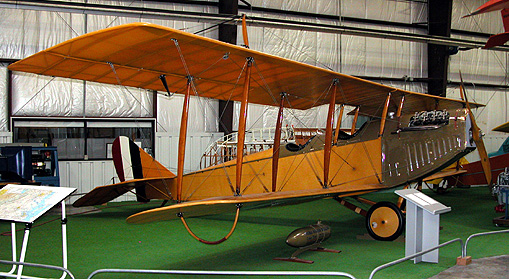
The Italian Aerospace Information Web
by Aeromedia - corso Giambone 46/18 - 10135 Torino (Italy)
Curtiss JN-4D Jenny, addestratore militare del 1916, al Virginia Aviation Museum, Byrd Field, Richmond (USA). Il Curtiss Jenny fu l’unico aeroplano costruito negli Stati Uniti che svolse un ruolo significativo, come addestratore e ricognitore, durante la Prima Guerra Mondiale. Oltre il 90% di tutti i piloti americani e canadesi dell’epoca impararono a volare con i Curtis Jenny. Il JN-4 diventò subito (ma ancor più in seguito) uno degli aeroplani più famosi della storia del volo. Ne vennero costruiti oltre 6.440 esemplari in varie versioni. Parecchi di loro sopravvissero alla Grande Guerra e vennero venduti ai privati. I Jenny vennero così utilizzati in lungo ed in largo negli Stati Uniti per le manifestazioni aeree itineranti e come “barnstormer” (assalitori di fienili). I piloti giravano di città in città esibendosi in voli spericolati, passeggiate sull’ala ed equilibrismi sul trapezio, per poi offrire il battesimo dell’aria agli spettatori più coraggiosi. Il Jenny formò per due decenni l’ossatura delle scuole di volo civili, divenne l’attore protagonista dei primi film a sfondo aeronautico e fu anche impiegato nei primi servizi sperimentali di posta aerea. In tal modo, il Jenny contribuì enormemente allo sviluppo dell’aviazione negli Stati Uniti. Il nome dell’aereo derivava dalla storpiatura della sigla “JN” in “Jenny”. L’esemplare esposto al Virginia Aviation Museum - un Curtiss JN-4N Jenny, matricola 2975 dei Signal Corps e numero di costruzione 450 – è stato messo cortesemente a disposizione dal proprietario Ken Hyde di Warrenton in Virginia. L’aereo fu costruito nello stabilimento della Curtiss Aeroplane di Buffalo, nello stato di New York, ed inviato in servizio al Taylor Field, nei pressi di Montgomery in Alabama, nel gennaio 1918. Alla fine della guerrà, esso passò di mano in mano a vari proprietari civili finchè, il 18 maggio 1970, venne acquistato da Ken Hyde. Dopo un accurato restauro funzionale da parte della 2000 Virginia Aviation Hall of Fame Inductee Ken Hyde, il 21 giugno 1986 “Signal Corps 2975” tornò a volare. Questo aereo si è aggiudicato l’Antique Grand Champion, premio assegnato al miglior aereo storico volante dall’Experimental Aircraft Association, durante il raduno di Oshkosh del 1987. Nello stesso anno, il velivolo è stato un protagonista del lungometraggio “Treasures from the Past” realizzato per la National Geographic Society.
Principali dati del Curtiss JN-4D Jenny (versione che ha volato per la prima volta nel 1916): biplano biposto per addestramento e ricognizione con fusoliera a sezione squadrata e struttura in legno; ali con longheroni in spruce massiccio e centine reticolari dello stesso materiale; gruppo impennaggi anch’esso in legno ed ali controventate con cavi d’acciaio; rivestimento completamente in tela salvo il vano motore in metallo; propulso da un motore a pistoni in linea Curtiss OX-5 da 90 CV ed elica bipala in legno; apertura alare 15,15 m; lunghezza 8,33 m; altezza 3 m; peso a vuoto 776 kg ed a pieno carico 966 kg; velocità massima 127 km/h all’altezza del mare; tangenza massima 3.350 m; nessun armamento. La versione JN-4D, in particolare, aveva gli alettoni solo sull’ala superiore e fu la prima ad adottare la nuova barra di comando “stick”. (Aeromedia)
Curtiss JN-4D Jenny, 1916 military trainer aircraft, at the Virginia Aviation Museum, Byrd Field, Richmond VA. The Curtiss Jenny was the only U.S. built aeroplane that played a significant role during WW I serving as a trainer and observation aircraft. Over 90 percent of all American and Canadian WW I pilots were trained in Curtis Jennies. The JN-4 became – then and subsequently – one of the best known aeroplanes ever to be built. More than 6,440 Jennies were built, in various models. Many of these airplanes survived the Great War and were sold to private individuals. Jenny’s were used throughout the U.S. as “barnstorming” and air show airplanes. Pilots performed stunt flying, wing-walking, aerial trapeze exhibitions and provided rides to the general public in Jenny’s. Civil flight schools used Jenny’s for pilot training and some of them were used for film making and to carry the first U.S. air mail. The Jenny really “made” the U.S. aviation in many ways. The aircraft name came from slurring the “JN” into “Jenny”. The Virginia Aviation Museum’s Curtiss JN-4N Jenny, Signal Corps number 2975 and S/N 450, is on gracious loan from Ken Hyde of Warrenton, VA. The aircraft was built in the Curtiss Aeroplane Factory in Buffalo, NY and shipped to Taylor Field near Montgomery, AL in January 1918. After WW I, it passed through several private owners and was finally purchased by Ken Hyde on May 18, 1970. After a complete restoration by 2000 Virginia Aviation Hall of Fame Inductee Ken Hyde, “Signal Corps number 2975” flew again on June 21, 1986. This airplane won EAA’s Antique Grand Champion at Oshkosh 1987 and was featured in the National Geographic’s “Treasures from the Past” in 1987.
Curtiss JN-4D Jenny main data: first flight of the model 1916; two-seat biplane trainer and observation aircraft with square-section fuselage build up of wood while the wings are made from solid spruce spars and spruce truss-type ribs; tail-group structure is wood and the wire-braced wings are covered with fabric as the fuselage except the engine area, which was covered with metal; powered by one 90 hp Curtiss OX-5 inline engine driving a two blade wood propeller; wing span 15.15 m (43 ft 7 in); lenght 8.33 m (27 ft 4 in); height 3 m (9 ft 10 in); weight empty 776 kg (1,580 lb); weight loaded 966 kg (2,130 lb); max speed 127 km/h (75 mph) at sea level; ceiling 3,350 m (11,000 ft); duration 2hr 15 min; no armament. The JN-4D had upper wing ailerons only and was the first model to introduce the new stick control. (Aeromedia)
